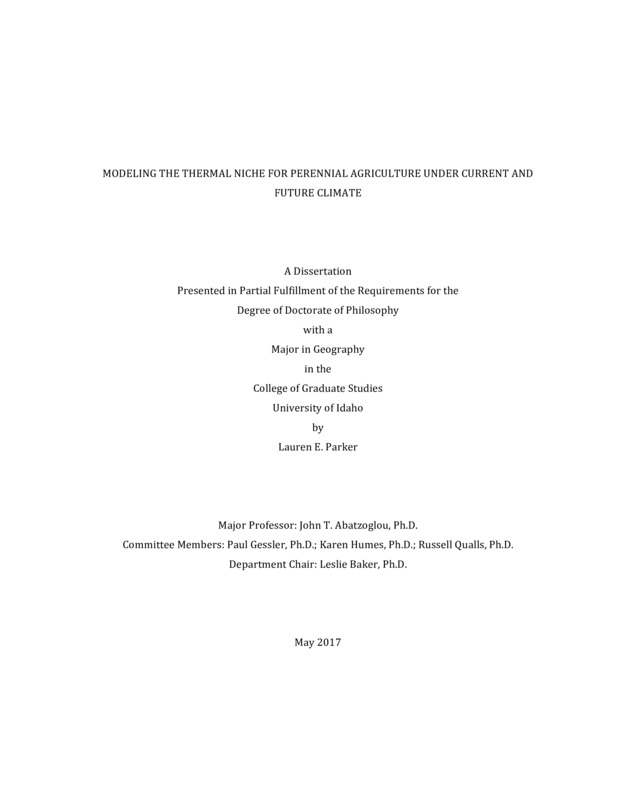Modeling the thermal niche for perennial agriculture under current and future climate
Parker, Lauren. (2017). Modeling the thermal niche for perennial agriculture under current and future climate. Theses and Dissertations Collection, University of Idaho Library Digital Collections. https://www.lib.uidaho.edu/digital/etd/items/parker_idaho_0089e_11074.html
- Title:
- Modeling the thermal niche for perennial agriculture under current and future climate
- Author:
- Parker, Lauren
- Date:
- 2017
- Embargo Remove Date:
- 2019-06-12
- Keywords:
- Almond Climate Change Cold Hardiness Species Distribution Modeling
- Program:
- Geography
- Subject Category:
- Climate change; Horticulture; Ecology
- Abstract:
-
Delineating locations viable for cultivating perennial crops has implications for economics, land use planning, water management, and food security at local, regional, national, and global scales. Provided that growing season water requirements for commercial perennial crops are typically met through irrigation, understanding the relationship between crop distribution and thermal variables is important for informing current agricultural practices, as well as when considering adaptive measures for climate change. Using almonds as an example, the changing geographies of suitable cultivation locations were examined under current and future climate, providing insight into opportunities cultivation expansion and translocation. One widely used measure of assessing the climatic suitability of a location for crop cultivation is the United States Department of Agriculture Plant Hardiness Zones (HZs), defined by average coldest annual temperatures. Evaluations of changes in winter temperatures showed a warming of the coldest temperatures by the mid-21st century, resulting in a northward shift in HZs across the United States and an expansion in the overwinter survival area for almonds. To address additional thermal constraints on species range, comparisons were made between two empirical species distribution models (SDMs) and a mechanistic model (MM) in modeling the thermal niche of almond. Results suggested that while using agriculturally relevant metrics in SDMs may improve SDM results, where data are available, an MM more effectively captures the interannual climate variability that is important for assessing suitability for cultivating perennials. Consequently, an MM was used to model future almond distribution. Model results showed that warmer mid-century temperatures reduced frost risk and increased annual heat accumulation across the northwestern US (NWUS), where such thermal conditions currently limit almond cultivation. In addition to range expansion, warming temperatures also resulted in a compression of crop development and a shift of crop phenology toward earlier maturation. While factors such as water availability, biotic interactions, and competing land use were not considered here, these results collectively suggest that translocation may be possible. Should non-thermal challenges to cultivation be manageable, geographic diversity in crop cultivation may provide an option for adapting perennial crop production to climate change and provide for economic and food supply stability.
- Description:
- doctoral, Ph.D., Geography -- University of Idaho - College of Graduate Studies, 2017
- Major Professor:
- Abatzoglou, John T
- Committee:
- Gessler, Paul; Humes, Karen; Qualls, Russell
- Defense Date:
- 2017
- Identifier:
- Parker_idaho_0089E_11074
- Type:
- Text
- Format Original:
- Format:
- application/pdf
- Rights:
- In Copyright - Educational Use Permitted. For more information, please contact University of Idaho Library Special Collections and Archives Department at libspec@uidaho.edu.
- Standardized Rights:
- http://rightsstatements.org/vocab/InC-EDU/1.0/

